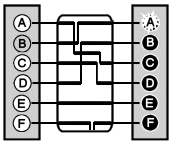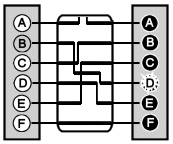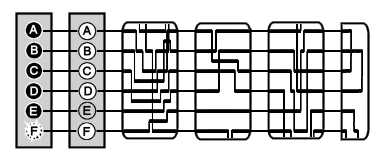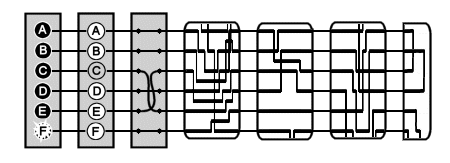|
The Enigma machine is quite simple in design and yet the result is a very powerful encryption device. It is a polyalphabetic substitution device; this means a different substitution alphabet is used for each letter of the message to be encrypted. This contrasts to a monoalphabetic substitution where only a single replacement alphabet is used for example the Caesar shift cipher where A becomes D, B becomes E, C becomes F, and so on for the rest of the alphabet.
The machine consists of a keyboard, a scrambling unit, and a lampboard, which are all electrically connected. The user types the message on the keyboard one key at a time, the key passes an electric current through the scrambler to light a lamp on the lampboard and the user makes a note of the letter that has been illuminated.
The scrambling unit consists of three discs called rotors and a reflector; this unit is the most important part of the Enigma machine. The rotors are so named because they rotate; the rotation of the rotors causes the substitution alphabet to change each time a key is pressed. Each rotor consists of a thick rubber disc threaded through with a complex series of wires, 26 inputs and outputs. Consider the action of just a single rotor; a key is pressed and a current passes along a pathway through the rotor to light a lamp. In the diagram pressing key B lights the A lamp

The rotor then rotates by a twenty-sixth of a full revolution, and the same key will light a different lamp as the current passes through a different pathway of the rotor. Now pressing key B will light lamp D.

It can be seen that if we were to use just a single rotor in the machine we would have returned back to the original setting after keys have been pressed twenty six times. This would result in only 26 substitution alphabets being used. However, by having three rotors the number of possible settings increases. The second rotor rotates by a twenty-sixth for every full revolution of the first rotor, and the third rotates by a twenty-sixth for every full revolution of the second. The result is 26x26x26 = 17 576 different settings which is a high level of complexity.
The reflector is the final component and is a simple fixed disc that 'reflects' the electric current back through the rotors by a different pathway and to the lampboard. The reflector has no cryptographic effect but is of huge importance because Enigma was used as both the encrypting device and the decrypting device. By typing the ciphertext into an Enigma machine with the same setting as the one used to encrypt the message the plaintext will be the result. For example if in a particular setting of Enigma the letter F is lit when the E key is pressed the reverse is true pressing the F key will light the E lamp.

This however is not the end of the story there are two further steps that are used to increase the cryptographic complexity. Firstly the rotors were designed to be removable so that they could be used in any order, this results in six different configurations. For example if the rotors were numbered 1, 2, and 3 the possible configurations are 123, 132, 213, 231, 312 and 321.
The second step is one that increases the possible configurations by a factor of over 100 billion and is the result of a device called a plugboard. The plugboard lies between the keyboard and the first rotor and allows the user to insert cables to swap letters before they enter the scramblers. For example if a cable was inserted to swap the letters C and E. Now the electrical pathway that would have been used for the letter E is used for the letter C and vice versa. The Enigma machine allowed for six pairs of letters to be swapped in this way, and the letters will remained swapped for the entire message. The result is shown below now lamp F is lit by pressing key C.

Although the plugboard creates the greatest number of possible configurations, it would be of no use all by itself. Because the letters that are swapped remain so for the entire message the result would be simply a monoalphabetic substitution a problem that is trivial to solve.
For more about Enigma see the pages History of Enigma and Cracking the Enigma.
You may also be interested in visiting the following websites which are the homes of two Enigma emulators.
http://www.attlabs.att.co.uk/andyc/enigma/enigma_j.html
www.izzy.net/~ian/enigma/applet/index.html
| 
